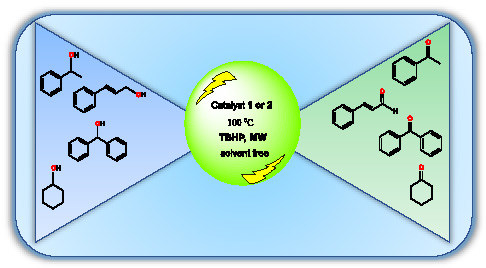Aroylhydrazone Schiff Base Derived Cu(II) and V(V) Complexes: Efficient Catalysts towards Neat Microwave-Assisted Oxidation of Alcohols
Abstract
:1. Introduction
2. Results and Discussion
2.1. Synthesis and Structural Characterization
2.2. General Description of the Crystal Structure
2.3. Catalytic Studies
3. Materials and Methods
3.1. Syntheses of the Pro-Ligand H4L
3.2. Synthesis of [Cu3(μ2-1κNO2,2κNO2-L)(μ-Cl)2(Cl)(MeOH)(DMF)2]2 (1)
3.3. Synthesis of [{VO(OEt)(EtOH)}2(1κNO2,2κNO2-L)]·2H2O (2)
3.4. X-ray Measurements
3.5. Catalytic Studies
Typical Procedures for the Catalytic Oxidation of Alcohols and Product Analysis
4. Conclusions
Supplementary Materials
Author Contributions
Funding
Acknowledgments
Conflicts of Interest
References
- Sutradhar, M.; Martins, L.M.D.R.S.; Guedes da Silva, M.F.C.; Pombeiro, A.J.L. Vanadium complexes: Recent progress in oxidation catalysis. Coord. Chem. Rev. 2015, 301–302, 200–239. [Google Scholar] [CrossRef]
- Sutradhar, M.; Pombeiro, A.J.L. Coordination chemistry of non-oxido, oxido and dioxidovanadium(IV/V) complexes with azine fragment ligands. Coord. Chem. Rev. 2014, 265, 89–124. [Google Scholar] [CrossRef]
- Sutradhar, M.; Kirillova, M.V.; Guedes da Silva, M.F.C.; Martins, L.M.D.R.S.; Pombeiro, A.J.L. A hexanuclear mixed-valence oxovanadium (IV,V) complex as a highly efficient alkane oxidation catalyst. Inorg. Chem. 2012, 51, 11229–11231. [Google Scholar] [CrossRef] [Green Version]
- Sutradhar, M.; Alegria, E.C.B.A.; Guedes da Silva, M.F.C.; Martins, L.M.D.R.S.; Pombeiro, A.J.L. Aroylhydrazone Cu(II) complexes in keto form: Structural characterization and catalytic activity towards cyclohexane oxidation. Molecules 2016, 21, 425. [Google Scholar] [CrossRef] [Green Version]
- Sutradhar, M.; Martins, L.M.D.R.S.; Guedes da Silva, M.F.C.; Liu, C.-M.; Pombeiro, A.J.L. Trinuclear Cu(II) structural isomers: Coordination, magnetism, electrochemistry and catalytic activity toward oxidation of alkanes. Eur. J. Inorg. Chem. 2015, 2015, 3959–3969. [Google Scholar] [CrossRef]
- Sutradhar, M.; Kirillova, M.V.; Guedes da Silva, M.F.C.; Liu, C.-M.; Pombeiro, A.J.L. Tautomeric effect of hydrazone Schiff bases in tetranuclear Cu(II) complexes: Magnetism and catalytic activity towards mild hydrocarboxylation of alkanes. Dalton Trans. 2013, 42, 16578–16587. [Google Scholar] [CrossRef] [PubMed]
- Sutradhar, M.; Martins, L.M.D.R.S.; Guedes da Silva, M.F.C.; Pombeiro, A.J.L. Oxido vanadium complexes with tridentate aroylhydrazone as catalyst precursors for solvent-free microwave-assisted oxidation of alcohol. Appl. Catal. A Gen. 2015, 493, 50–57. [Google Scholar] [CrossRef]
- Sutradhar, M.; Martins, L.M.D.R.S.; Guedes da Silva, M.F.C.; Alegria, E.C.B.A.; Liu, C.-M.; Pombeiro, A.J.L. Dinuclear Mn(II,II) complexes: Magnetic properties and microwave assisted oxidation of alcohols. Dalton Trans. 2014, 43, 3966–3977. [Google Scholar] [CrossRef]
- Sutradhar, M.; Alegria, E.C.B.A.; Mahmudov, K.T.; Guedes da Silva, M.F.C.; Pombeiro, A.J.L. Iron(III) and cobalt(III) complexes with both tautomeric (keto and enol) forms of aroylhydrazone ligands: Catalysts for the microwave assisted oxidation of alcohols. RSC Adv. 2016, 6, 8079–8088. [Google Scholar] [CrossRef]
- Sutradhar, M.; Carrella, L.M.; Rentschler, E. A discrete μ4-oxido tetranuclear iron(III) cluster. Eur. J. Inorg. Chem. 2012, 2012, 4273–4278. [Google Scholar] [CrossRef]
- Sutradhar, M.; Alegria, E.C.B.A.; Roy Barman, T.; Scorcelletti, F.; Guedes da Silva, M.F.C.; Pombeiro, A.J.L. Microwave-assisted peroxidative oxidation of toluene and 1-phenylethanol with monomeric keto and polymeric enol aroylhydrazone Cu(II) complexes. Mol. Catal. 2017, 439, 224–232. [Google Scholar] [CrossRef]
- Sutradhar, M.; Roy Barman, T.; Pombeiro, A.J.L.; Martins, L.M.D.R.S. Catalytic activity of polynuclear vs. dinuclear Aroylhydrazone Cu(II) complexes in microwave-assisted oxidation of neat aliphatic and aromatic hydrocarbons. Molecules 2019, 24, 47. [Google Scholar] [CrossRef] [Green Version]
- Sutradhar, M.; Roy Barman, T.; Pombeiro, A.J.L.; Martins, L.M.D.R.S. Ni(II)-aroylhydrazone complexes as catalyst Precursors towards efficient solvent-free Nitroaldol condensation Reaction. Catalysts 2019, 9, 554. [Google Scholar] [CrossRef] [Green Version]
- Sutradhar, M.; Martins, L.M.D.R.S.; Roy Barman, T.; Kuznetsov, M.L.; Guedes da Silva, M.F.C.; Pombeiro, A.J.L. Vanadium complexes of different nuclearities in the catalytic oxidation of cyclohexane and cyclohexanol—An experimental and theoretical investigation. New J. Chem. 2019, 43, 17557–17570. [Google Scholar] [CrossRef]
- Sheldon, R.A.; Arends, I.W.C.E.; Ten Brink, G.J.; Dijksman, A.G. Catalytic Oxidations of Alcohols. Acc. Chem. Res. 2002, 35, 774–781. [Google Scholar] [CrossRef] [PubMed]
- Punniyamurthy, T.; Velusamy, S.; Iqbal, J. Recent Advances in Transition MetalCatalyzed Oxidation of Organic Substrates with Molecular Oxygen. Chem. Rev. 2005, 105, 2329–2364. [Google Scholar] [CrossRef]
- Martins, L.M.D.R.S. C-scorpionate complexes: Ever young catalytic tools. Coord. Chem. Rev. 2019, 396, 89–102. [Google Scholar] [CrossRef]
- Martins, L.M.D.R.S.; Pombeiro, A.J.L. Tris(pyrazol-1yl)methane metal complexes for catalytic mild oxidative functionalizations of alkanes, alkenes and ketones. Coord. Chem. Rev. 2014, 265, 74–88. [Google Scholar] [CrossRef]
- Ribeiro, A.P.C.; Martins, L.M.D.R.S.; Hazra, S.; Pombeiro, A.J.L. Catalytic Oxidation of Cyclohexane with Hydrogen Peroxide and a Tetracopper(II) Complex in an Ionic Liquid. C. R. Chim. 2015, 18, 758–765. [Google Scholar] [CrossRef]
- Gupta, S.; Kirillova, M.V.; Guedes da Silva, M.F.C.; Pombeiro, A.J.L. Highly efficient divanadium(V) pre-catalyst for mild oxidation of liquid and gaseous alkanes. Appl. Catal. A 2013, 460–461, 82–89. [Google Scholar] [CrossRef]
- Timokhin, I.; Pettinari, C.; Marchetti, F.; Pettinari, R.; Condello, F.; Galli, S.; Alegria, E.C.B.A.; Martins, L.M.D.R.S.; Pombeiro, A.J.L. Novel Coordination Polymers with (Pyrazolato)-based Tectons: Catalytic Activity in the Peroxidative Oxidation of Alcohols and Cyclohexane. Cryst. Growth Des. 2015, 15, 2303–2317. [Google Scholar] [CrossRef]
- Ahmed, A.H.; Hassan, A.M.; Gumaa, H.A.; Mohamed, B.H.; Eraky, A.M.; Omran, A.A. Copper(II)-oxaloyldihydrazone complexes: Physico-chemical studies: Energy band gap and inhibition evaluation of free oxaloyldihydrazones toward the corrosion of copper metal in acidic medium. Arabian J. Chem. 2019, 12, 4287–4302. [Google Scholar] [CrossRef] [Green Version]
- Marko, I.E.; Giles, P.R.; Tsukazaki, M.; Brown, S.M. Copper-Catalyzed Oxidation of Alcohols to Aldehydes and Ketones: An E_cient, Aerobic Alternative. Science 1996, 274, 2044–2046. [Google Scholar] [CrossRef] [PubMed] [Green Version]
- Larock, R.C. Comprehensive Organic Transformations; Wiley-VCH: New York, NY, USA, 1999. [Google Scholar]
- Wang, X.; Wu, G.; Wei, W.; Sun, Y. Solvent-free oxidation of alcohols by hydrogen peroxide over chromium Schiff base complexes immobilized on MCM-41. Trans. Met. Chem. 2010, 35, 213–220. [Google Scholar] [CrossRef]
- Farhadi, S.; Zaidi, M. Polyoxometalate–zirconia (POM/ZrO2) nanocomposite prepared by sol-gel process: A green and recyclable photocatalyst for efficient and selective aerobic oxidation of alcohols into aldehydes and ketones. Appl. Catal. A 2009, 354, 119–126. [Google Scholar] [CrossRef]
- Brühne, F.; Wright, E. Benzaldehyde, Ullmann’s Encyclopedia of Industrial Chemistry; Wiley-VCH Verlag GmbH & Co. KGaA: Weinheim, Germany, 2011; Volume 5, pp. 223–233. [Google Scholar]
- Lee, D.G.; Spitzer, U.A. Aqueous dichromate oxidation of primary alcohols. J. Org. Chem. 1970, 35, 3589–3590. [Google Scholar] [CrossRef]
- Prabhakaran, P.V.; Venkatachalam, S.; Ninan, K.N. Permanganate ion supported over crosslinked polyvinylamine as an oxidising agent for alcohols. Eur. Polym. J. 1999, 35, 1743–1746. [Google Scholar] [CrossRef]
- Abad, A.; Almela, C.; Corma, A.; García, H. E_cient chemoselective alcohol oxidation using oxygen as oxidant. Superior performance of gold over palladium catalysts. Tetrahedron 2006, 62, 6666–6672. [Google Scholar] [CrossRef]
- Tojo, G.; Fernandez, M. Oxidation of Alcohols to Aldehydes and Ketones: A Guide to Current Common Practice; Springer: New York, NY, USA, 2006. [Google Scholar]
- Bailey, J.E.; Bohnet, M. Ullmann’s Encyclopedia of Industrial Chemistry, 6th ed.; Wiley-VCH: Weinheim, Germany, 1999–2013. [Google Scholar]
- Sutradhar, M.; Roy Barman, T.; Alegria, E.C.B.A.; Guedes da Silva, M.F.C.; Liu, C.-M.; Kou, H.-Z.; Pombeiro, A.J.L. Cu(II) complexes of N-rich aroylhydrazone: Magnetism and catalytic activity towards microwave-assisted oxidation of xylenes. Dalton Trans. 2019, 48, 12839–12849. [Google Scholar] [CrossRef]
- Sutradhar, M.; Roy Barman, T.; Pombeiro, A.J.L.; Martins, L.M.D.R.S. Cu(II) and Fe(III) Complexes Derived from N-Acetylpyrazine-2-Carbohydrazide as Efficient Catalysts Towards Neat Microwave Assisted Oxidation of Alcohols. Catalysts 2019, 9, 1053. [Google Scholar] [CrossRef] [Green Version]
- Mardani, H.R.; Golchoubian, H. E_ective oxidation of benzylic and aliphatic alcohols with hydrogen peroxide catalyzed by a manganese(III) Schiff-base complex under solvent-free conditions. Tetrahedron Lett. 2006, 47, 2349–2352. [Google Scholar] [CrossRef]
- Moiseeva, I.N.; Gekham, A.E.; Minin, V.V.; Larin, G.M.; Bashtanov, M.E.; Krasnovskii, A.A.; Moiseev, I.I. Free radical/singlet dioxygen system under the conditions of catalytic hydrogen peroxide decomposition. Kinet. Catal. 2000, 41, 170–177. [Google Scholar] [CrossRef]
- Figiel, P.J.; Leskelä, M.; Repo, T. TEMPO-Copper(II) Diimine-Catalysed Oxidation of Benzylic Alcohols in Aqueous Media. Adv. Synth. Catal. 2007, 349, 1173–1179. [Google Scholar] [CrossRef]
- Ahmad, J.U.; Figiel, P.J.; Räisänen, M.T.; Leskelä, M.; Repo, T. Aerobic oxidation of benzylic alcohols with bis(3,5-di-tert-butylsalicylaldimine)copper(II) complexes. Appl. Catal. A 2009, 371, 17–21. [Google Scholar] [CrossRef]
- Bruker, APEX2 & SAINT; AXS Inc.: Madison, WI, USA, 2004.
- Altomare, A.; Burla, M.C.; Camalli, M.; Cascarano, G.L.; Giacovazzo, C.; Guagliardi, A.; Moliterni, A.G.G.; Polidori, G.; Spagna, R. SIR97: A New Tool for Crystal Structure Determination and Refinement. J. Appl. Cryst. 1999, 32, 115–119. [Google Scholar] [CrossRef]
- Sheldrick, G.M. A Short History of SHELX. Acta Crystallogr. Sect. C 2015, 71, 3–8. [Google Scholar] [CrossRef]
- Farrugia, L.J. WinGX and ORTEP for Windows: An Update. J. Appl. Cryst. 2012, 45, 849–854. [Google Scholar] [CrossRef]
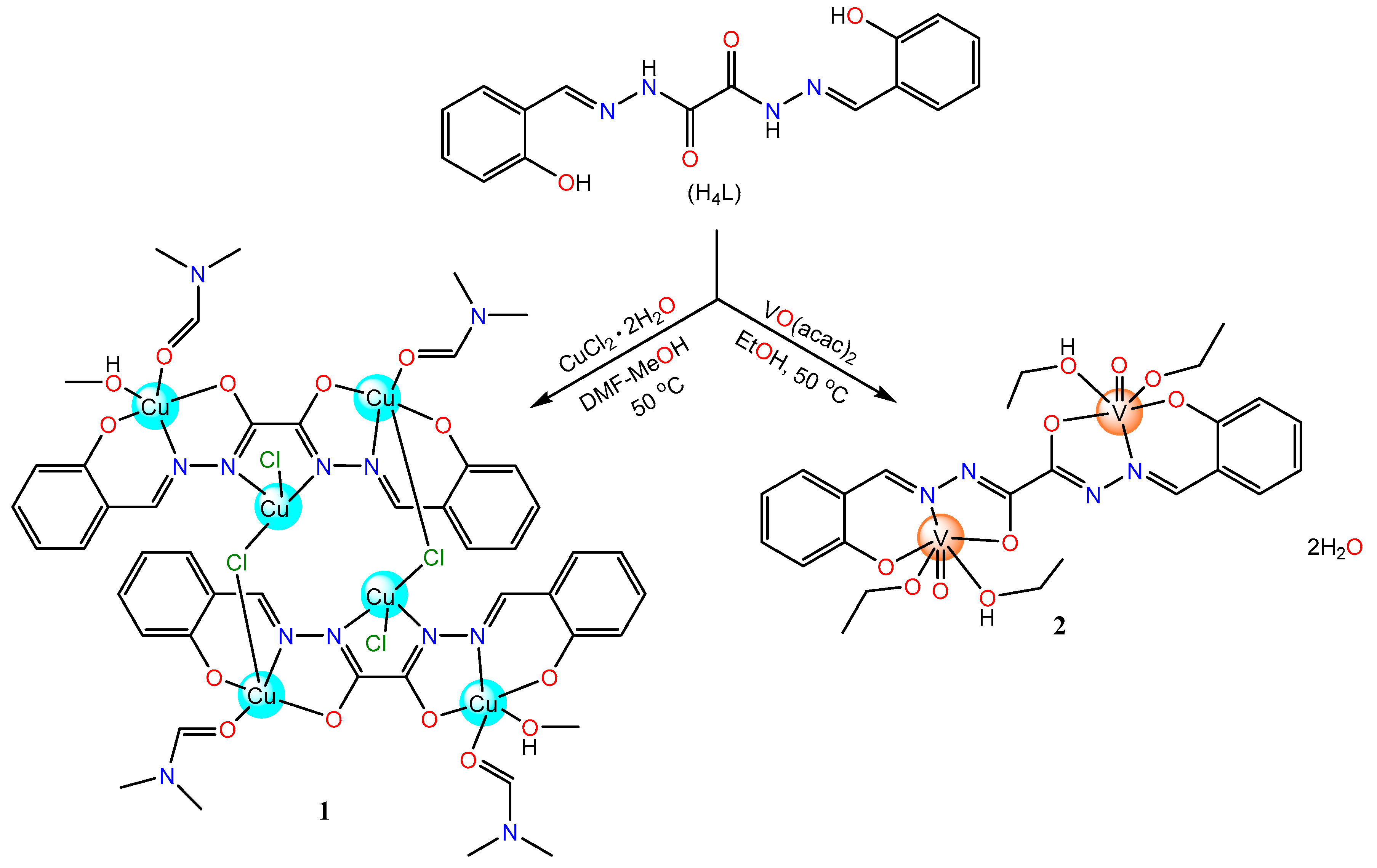
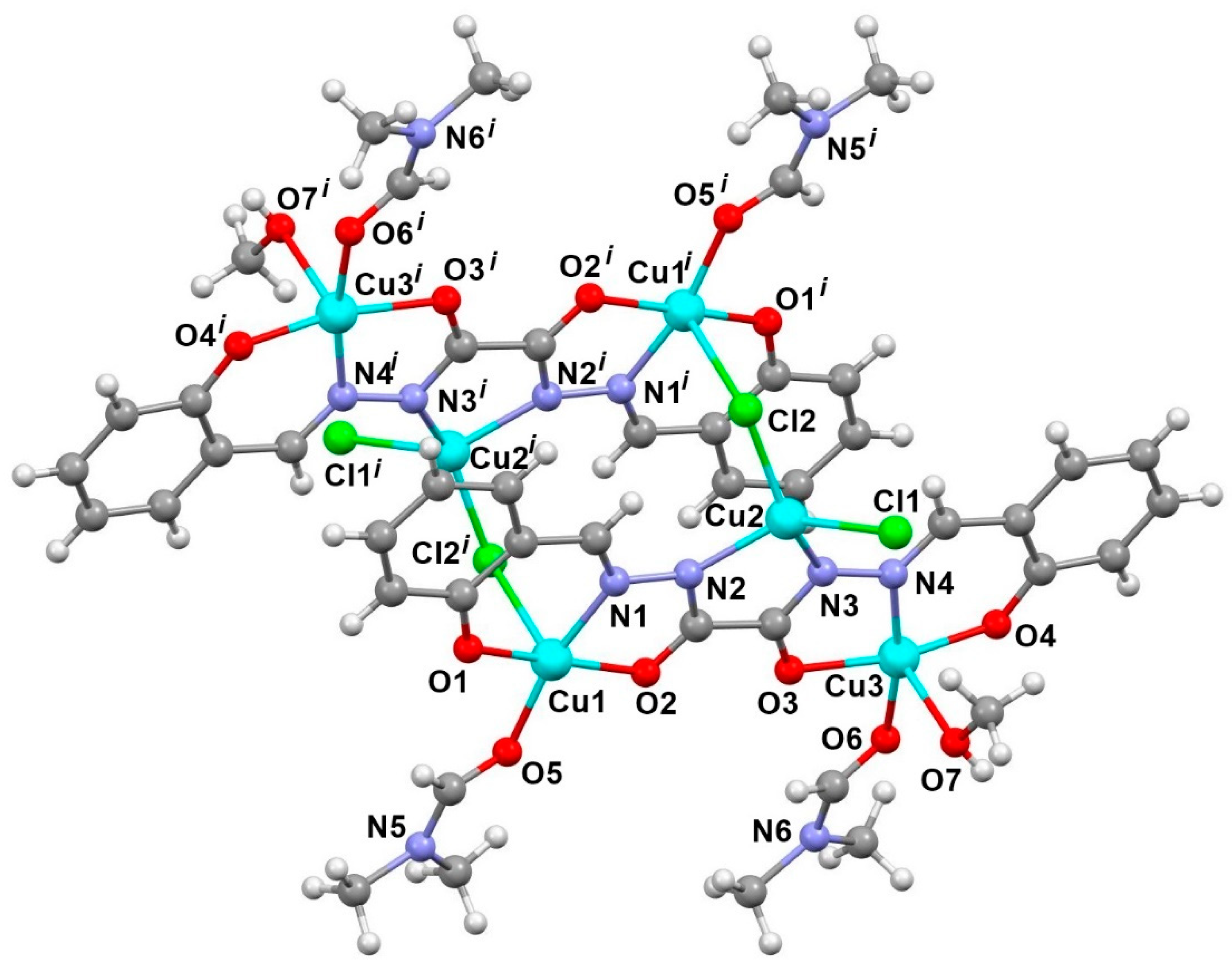

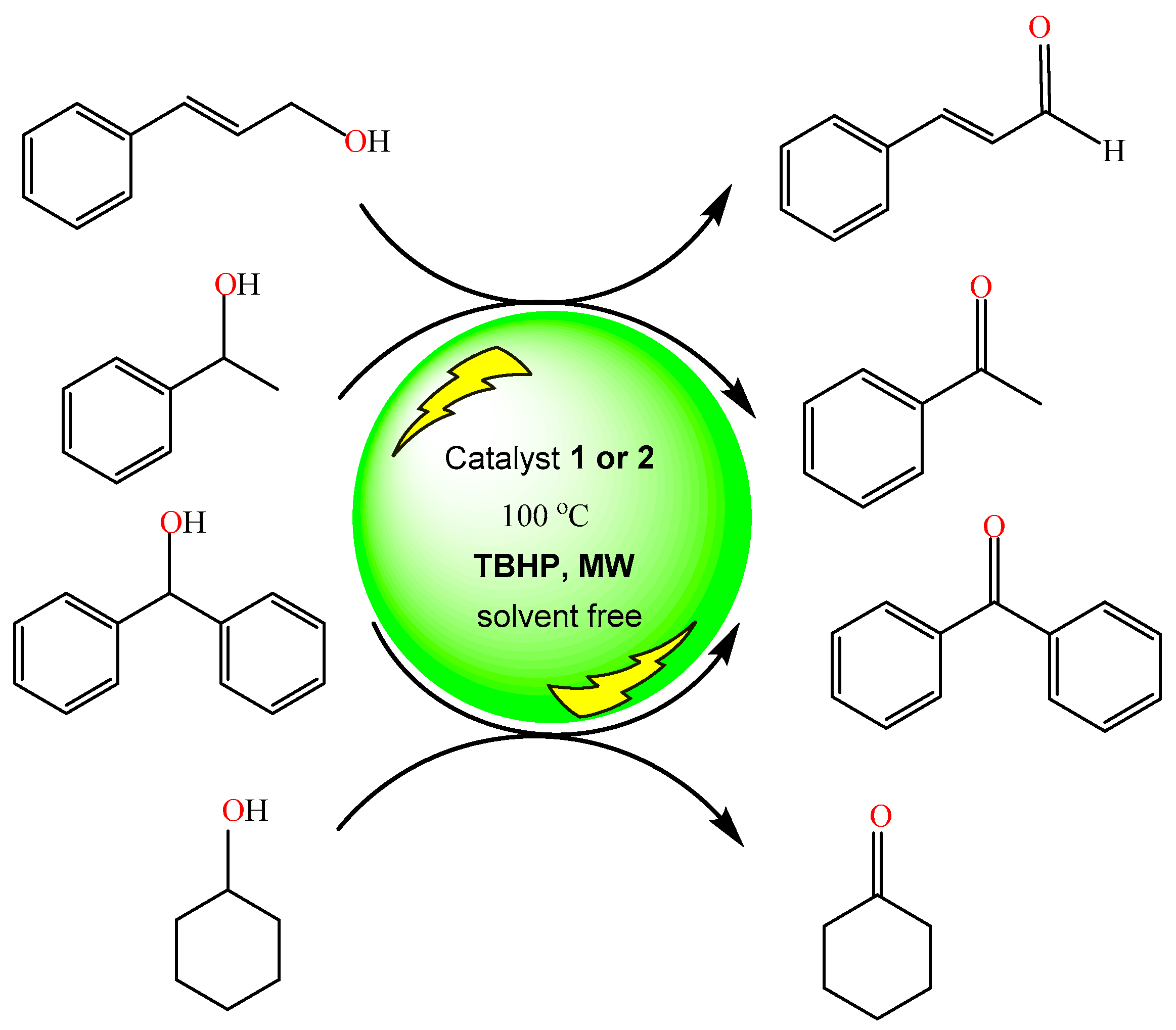
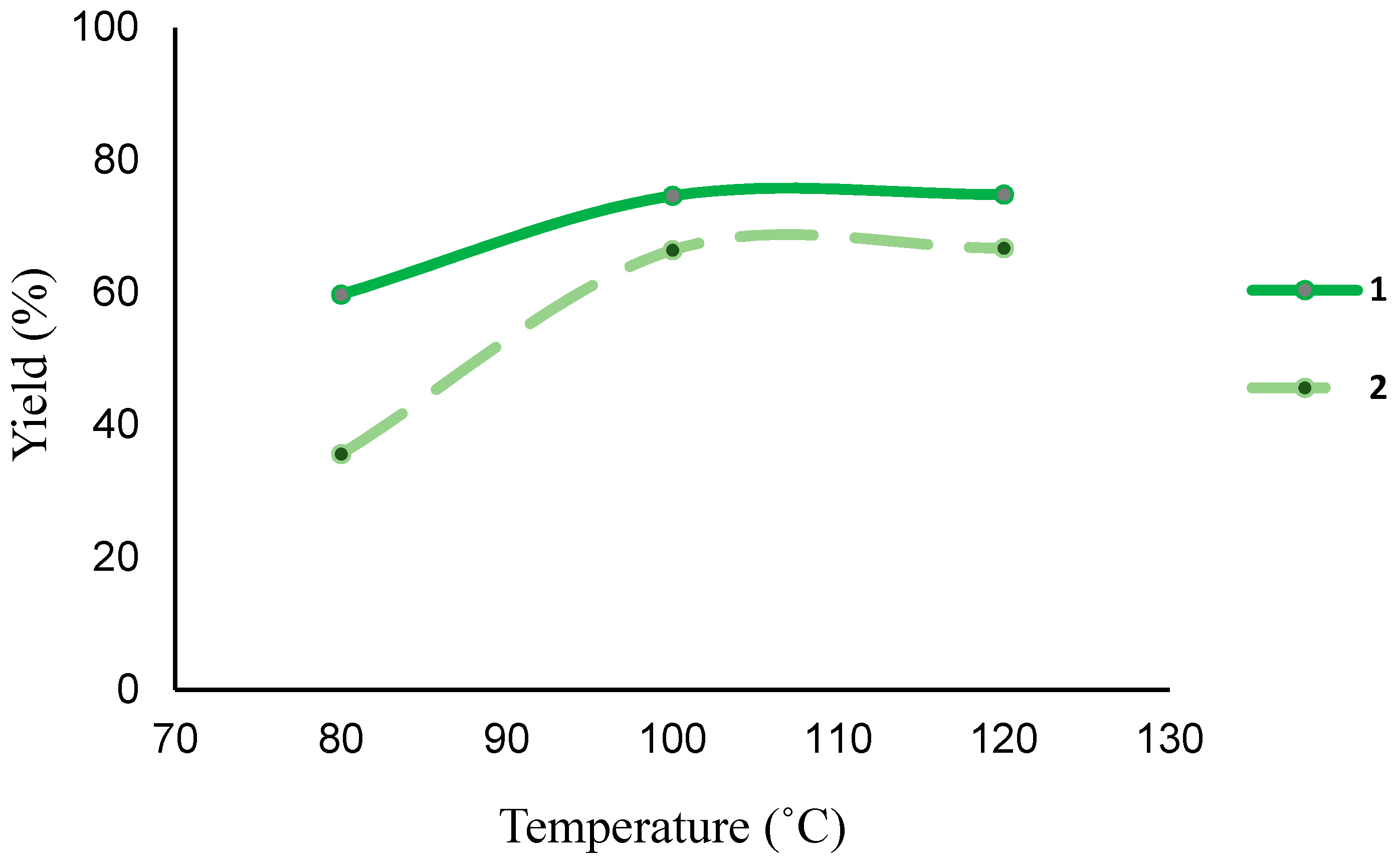



| Parameters | 1 |
|---|---|
| Empirical formula | C23H28Cl2Cu3N6O7 |
| Formula weight | 762.03 |
| Crystal system | Triclinic |
| Space group | P¯1 |
| Temperature/K | 296 (2) |
| a/Å | 7.7742 (9) |
| b/Å | 11.9744 (12) |
| c/Å | 17.287 (2) |
| α/° | 104.505 (6) |
| β/° | 98.430 (6) |
| γ/° | 106.176 (4) |
| V (Å3) | 1455.2 (3) |
| Z | 2 |
| Dcalc (g cm−3) | 1.739 |
| μ (Mo Kα) (mm−1) | 2.41 |
| Rfls. collected/unique/observed | 28371/7251/4657 |
| Rint | 0.082 |
| Final R1 a, wR2 b (I ≥ 2σ) | 0.044, 0.087 |
| Goodness-of-fit on F2 | 1.01 |
| Cu2—N3 | 1.978 (3) | Cu3—O6 | 1.983 (2) |
| Cu2—N2 | 2.009 (3) | Cu3—O7 | 2.321 (3) |
| Cu2—Cl1 | 2.2258 (10) | Cu1—O1 | 1.887 (2) |
| Cu2—Cl2 | 2.2307 (9) | Cu1—N1 | 1.937 (3) |
| Cu3—O4 | 1.904 (2) | Cu1—O5 | 1.953 (2) |
| Cu3—N4 | 1.933 (3) | Cu1—O2 | 1.962 (2) |
| Cu3—O3 | 1.977 (2) | ||
| N3—Cu2—N2 | 80.89 (10) | O3—Cu3—O6 | 90.12 (9) |
| N3—Cu2—Cl1 | 97.27 (8) | O4—Cu3—O7 | 92.69 (11) |
| N2—Cu2—Cl1 | 142.23 (9) | N4—Cu3—O7 | 93.64 (11) |
| N3—Cu2—Cl2 | 147.92 (9) | O3—Cu3—O7 | 98.84 (10) |
| N2—Cu2—Cl2 | 103.72 (8) | O6—Cu3—O7 | 92.74 (11) |
| Cl1—Cu2—Cl2 | 97.50 (4) | O1—Cu1—N1 | 94.45 (10) |
| O4—Cu3—N4 | 93.33 (10) | O1—Cu1—O5 | 93.38 (10) |
| O4—Cu3—O3 | 167.56 (11) | N1—Cu1—O5 | 168.00 (11) |
| N4—Cu3—O3 | 81.34 (10) | O1—Cu1—O2 | 173.56 (11) |
| O4—Cu3—O6 | 94.00 (10) | N1—Cu1—O2 | 81.41 (10) |
| N4—Cu3—O6 | 170.04 (11) | O5—Cu1—O2 | 89.97 (10) |
| Entry | Catalyst | Substrate | Temperature (°C) | Reaction Time (h) | Additive | Yield (%) b | TON (TOF (h−1)) c |
|---|---|---|---|---|---|---|---|
| 1 | 1 | 1-phenyl ethanol | 80 | 0.5 | - | 59.7 | 299 (598) |
| 2 | 100 | 0.5 | - | 74.6 | 373 (746) | ||
| 3 | 120 | 0.5 | - | 74.8 | 374 (748) | ||
| 4 | 100 | 1.0 | - | 95.3 | 476 (476) | ||
| 5 | 100 | 1.5 | - | 94.9 | 475 (317) | ||
| 6 | 100 | 2.0 | - | 91.2 | 327 (164) | ||
| 7 d | 100 | 1 | - | 76.6 | 383 (383) | ||
| 8 d | 100 | 6 | 96.8 | 484 (81) | |||
| 9 e | 100 | 1 | HNO3 | 27.2 | 136 (136) | ||
| 10 f | 100 | 1 | HPCA | 54.8 | 274 (274) | ||
| 11 g | 100 | 1 | TEMPO | 94.7 | 474 (474) | ||
| 12 h | 100 | 1 | Ph2NH | 7.9 | 40 (40) | ||
| 13 | cinnamyl alcohol | 100 | 1 | - | 12.6 | 63 (63) | |
| 14 g | 100 | 1 | TEMPO | 12.0 | 60 (60) | ||
| 15 h | 100 | 1 | Ph2NH | 1.6 | 8 (8) | ||
| 16 | benzhydrol | 100 | 1 | - | 81.7 | 409 (409) | |
| 17 g | 100 | 1 | TEMPO | 80.9 | 405 (405) | ||
| 18 h | 100 | 1 | Ph2NH | 3.2 | 16 (16) | ||
| 19 | cyclohexanol | 100 | 1 | - | 70.5 | 353 (353) | |
| 20 g | 100 | 1 | TEMPO | 71.0 | 355 (355) | ||
| 21h | 100 | 1 | Ph2NH | 3.4 | 178 (356) | ||
| 22 | 2 | 1-phenyl ethanol | 80 | 0.5 | - | 35.6 | 178 (356) |
| 23 | 100 | 0.5 | - | 66.4 | 332 (664) | ||
| 24 | 120 | 0.5 | - | 66.7 | 326 (652) | ||
| 25 | 100 | 1.0 | - | 88.5 | 443 (443) | ||
| 26 | 100 | 1.5 | - | 88.2 | 441 (294) | ||
| 27 | 100 | 2.0 | - | 86.9 | 435 (218) | ||
| 28 d | 100 | 1.0 | - | 67.8 | 339 (339) | ||
| 29 e | 100 | 1.0 | HNO3 | 16.7 | 84 (84) | ||
| 30 f | 100 | 1.0 | HPCA | 45.6 | 228 (228) | ||
| 31 g | 100 | 1.0 | TEMPO | 92.1 | 461 (461) | ||
| 32 h | 100 | 1.0 | Ph2NH | 6.7 | 34 (34) | ||
| 33 | cinnamyl alcohol | 100 | 1.0 | - | 5.7 | 133 (133) | |
| 34 g | 100 | 1.0 | TEMPO | 7.2 | 36 (36) | ||
| 35 | benzhydrol | 100 | 1.0 | - | 73.4 | 367 (367) | |
| 36 g | 100 | 1.0 | TEMPO | 79.8 | 399 (399) | ||
| 37 | cyclohexanol | 100 | 1.0 | - | 65.8 | 329 (329) | |
| 38 g | 100 | 1.0 | TEMPO | 67.9 | 340 (340) | ||
| 39 | CuCl2·2H2O | 1-phenyl ethanol | 100 | 1.0 | - | 6.2 | 31 (31) |
| 40 | cinnamyl alcohol | 100 | 1.0 | - | 1.7 | 9 (9) | |
| 41 | benzhydrol | 100 | 1.0 | - | 4.4 | 22 (22) | |
| 42 | cyclohexanol | 100 | 1.0 | - | 3.5 | 18 (18) | |
| 43 | VO(acac)2 | 1-phenyl ethanol | 100 | 1.0 | - | 4.9 | 25 (25) |
| 44 | cinnamyl alcohol | 100 | 1.0 | - | 1.1 | 6 (6) | |
| 45 | benzhydrol | 100 | 1.0 | - | 3.6 | 18 (18) | |
| 46 | cyclohexanol | 100 | 1.0 | - | 2.8 | 14 (14) | |
© 2020 by the authors. Licensee MDPI, Basel, Switzerland. This article is an open access article distributed under the terms and conditions of the Creative Commons Attribution (CC BY) license (http://creativecommons.org/licenses/by/4.0/).
Share and Cite
Sutradhar, M.; Roy Barman, T.; Pombeiro, A.J.L.; Martins, L.M.D.R.S. Aroylhydrazone Schiff Base Derived Cu(II) and V(V) Complexes: Efficient Catalysts towards Neat Microwave-Assisted Oxidation of Alcohols. Int. J. Mol. Sci. 2020, 21, 2832. https://doi.org/10.3390/ijms21082832
Sutradhar M, Roy Barman T, Pombeiro AJL, Martins LMDRS. Aroylhydrazone Schiff Base Derived Cu(II) and V(V) Complexes: Efficient Catalysts towards Neat Microwave-Assisted Oxidation of Alcohols. International Journal of Molecular Sciences. 2020; 21(8):2832. https://doi.org/10.3390/ijms21082832
Chicago/Turabian StyleSutradhar, Manas, Tannistha Roy Barman, Armando J. L. Pombeiro, and Luísa M. D. R. S. Martins. 2020. "Aroylhydrazone Schiff Base Derived Cu(II) and V(V) Complexes: Efficient Catalysts towards Neat Microwave-Assisted Oxidation of Alcohols" International Journal of Molecular Sciences 21, no. 8: 2832. https://doi.org/10.3390/ijms21082832
APA StyleSutradhar, M., Roy Barman, T., Pombeiro, A. J. L., & Martins, L. M. D. R. S. (2020). Aroylhydrazone Schiff Base Derived Cu(II) and V(V) Complexes: Efficient Catalysts towards Neat Microwave-Assisted Oxidation of Alcohols. International Journal of Molecular Sciences, 21(8), 2832. https://doi.org/10.3390/ijms21082832







